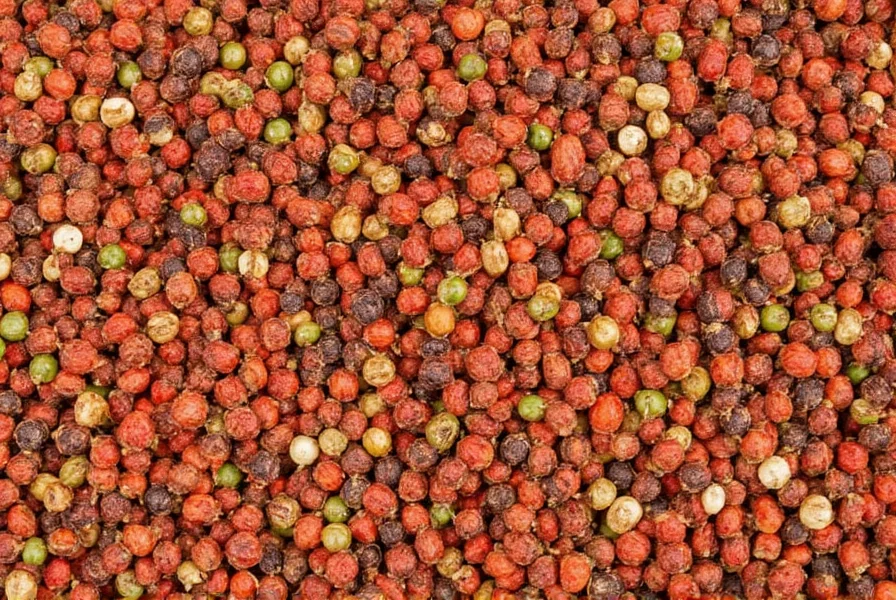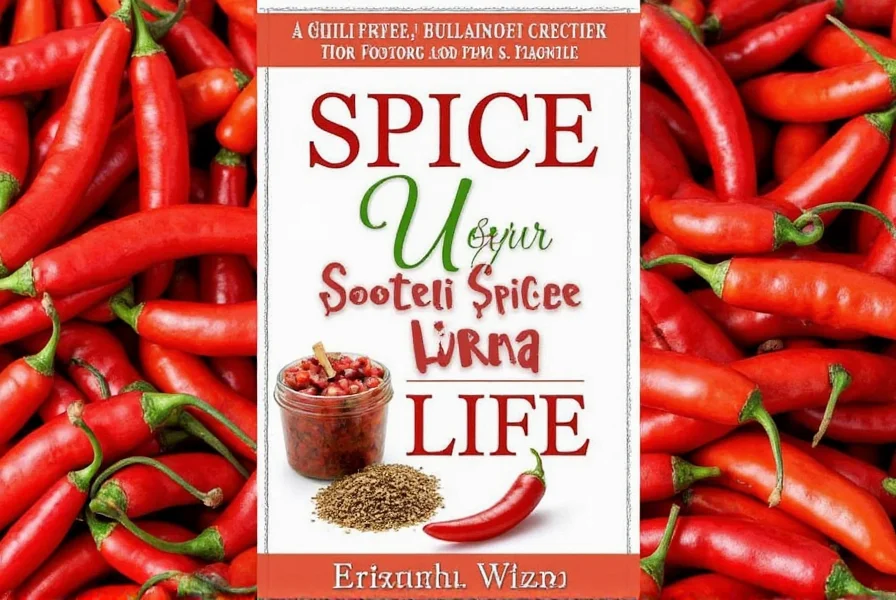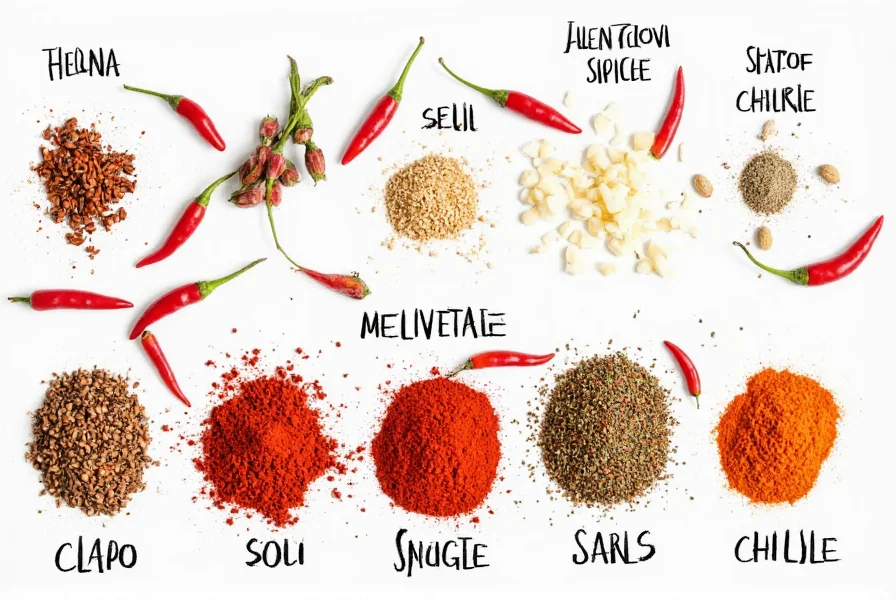| Chili Pepper | Heat Level (Scoville Units) | Flavor Profile | Common Uses |
|---|---|---|---|
| Tabasco | 30,000–50,000 | Sour, tangy | Hot sauce, marinades |
| Habanero | 100,000–350,000 | Smoky, sweet | Curries, salsas, desserts |
| Chipotle | 2,500–8,000 | Smoky, earthy | Stews, sauces, grilled meats |
| Jalapeño | 2,500–5,000 | Peppery, mild | Salsas, tacos, pickling |
| Cayenne | 30,000–50,000 | Sharp, hot | Seasoning, hot sauces, rubs |
Introduction to Chili Spices Ingredients
Chili spices ingredients are the heart of many global cuisines, bringing heat, flavor, and depth to dishes. Whether you're a professional chef or a home cook with a passion for spicy food, understanding these ingredients can transform your cooking experience. From the smoky chipotle to the fiery habanero, each chili has its own unique profile that can elevate any meal.
But what exactly makes a chili spice special? It all comes down to the type of pepper used, how it's processed, and the compounds that give it its signature heat. The key ingredient in chilies is capsaicin, which not only provides the heat but also offers some health benefits. So, whether you're looking to add a kick to your next dish or explore the world of chili spices, this guide will help you navigate the exciting world of chili ingredients.
Types of Chili Spices Ingredients
There are countless types of chili peppers, each with its own unique characteristics. Here are some of the most popular ones:
Practical Tips for Using Chili Spices
Whether you're new to chili spices or an experienced cook, here are some practical tips to help you make the most of these ingredients:
- Start Small: Chilies can be incredibly potent. If you're unsure about the heat level, start with a small amount and adjust as needed.
- Use Gloves: Capsaicin can cause irritation if it comes into contact with your skin or eyes. Always wear gloves when handling fresh chilies.
- Balance Heat with Flavor: Pair spicy chilies with acidic or sweet ingredients to create a more balanced flavor profile. For example, adding lime juice to a spicy salsa can help mellow out the heat.
- Experiment with Roasting: Roasting chilies enhances their natural sweetness and adds a rich, smoky flavor. Try roasting jalapeños or poblanos before using them in salsas or sauces.
- Store Properly: Fresh chilies should be stored in a cool, dry place or in the refrigerator. Dried chilies can be kept in an airtight container for several months.
One of the best ways to enjoy chili spices is by experimenting with different combinations. For instance, blending cayenne with smoked paprika can create a complex, layered flavor that works well in rubs and marinades. Similarly, mixing chipotle with adobo sauce gives a bold, smoky heat that's perfect for tacos or grilled vegetables.
Don't forget to consider the texture of the chili as well. Some chilies, like the poblano, have a thick flesh that holds up well in stews, while others, like the serrano, are great for slicing into salads or using in salsas.
Buying Guide for Chili Spices Ingredients
1. Dried Chili Peppers
Dried chilies are a staple in many kitchens. They offer a concentrated flavor and can be rehydrated for use in sauces, soups, and stews. Some popular dried varieties include:
- Guajillo: Medium heat, rich flavor, great for mole sauces.
- Ancho: Mild to medium heat, sweet and smoky, ideal for enchiladas and stews.
- Arbol: Hot and sharp, perfect for making spicy pastes and salsas.

When purchasing dried chilies, look for those that are plump, firm, and free from mold or discoloration. Store them in an airtight container in a cool, dark place to maintain their quality.
2. Fresh Chili Peppers
For those who prefer the vibrant, raw flavor of fresh chilies, there are plenty of options at local markets or grocery stores. Fresh chilies are best used immediately, as they tend to lose their potency over time.
Some common fresh chilies include:
- Jalapeño: Versatile and mild, perfect for salsas and stuffed peppers.
- Serrano: Hotter than jalapeños, great for making hot sauces and salsas.
- Poblano: Mild to medium heat, ideal for roasting and stuffing.

When selecting fresh chilies, choose ones that are firm, glossy, and free from blemishes. Avoid any that feel soft or wrinkled, as they may be past their prime.
3. Chili Powder and Spice Blends
If you're short on time or want to add a quick boost of heat to your dishes, chili powder and spice blends are a convenient option. These products are typically made from ground chilies mixed with other seasonings like garlic, cumin, and oregano.
Popular chili-based spice blends include:
- Mexican Seasoning: A mix of chili powder, garlic, onion, and cumin.
- Caribbean Jerk Seasoning: Combines chili, allspice, thyme, and nutmeg for a bold flavor.
- Indian Garam Masala: While not strictly chili-based, it often includes chili powder for added heat.
When choosing chili powder or spice blends, look for high-quality products that contain no unnecessary fillers or preservatives. Check the label for the percentage of chili content and the variety of chilies used.
4. Hot Sauces and Pastes
Hot sauces and pastes are excellent for adding instant heat to your meals. They come in a wide range of flavors, from tangy and smoky to sweet and fruity.
Some popular hot sauces include:
- Tabasco: A classic hot sauce made from tabasco peppers, vinegar, and salt.
- Frank's RedHot: A popular American hot sauce known for its bold flavor.
- Cholula: A versatile sauce with a balance of heat and flavor.

When buying hot sauces, consider the heat level, flavor profile, and how they pair with different dishes. Some sauces are better suited for cooking, while others are ideal for finishing touches on sandwiches or tacos.
Frequently Asked Questions About Chili Spices Ingredients
What is the difference between fresh and dried chili peppers?
Fresh chili peppers offer a bright, vibrant flavor and varying heat levels depending on the variety. They're ideal for salsas, salads, and dishes where you want a fresh pepper taste. Dried chilies have a more concentrated, complex flavor with earthier notes. The drying process often enhances smoky characteristics and changes the heat profile. Dried chilies need to be rehydrated before use in most recipes and are commonly used in sauces, stews, and spice blends.
How should I store chili spices to maintain their freshness and potency?
For optimal storage: Fresh chilies should be kept in the refrigerator's crisper drawer in a paper bag (not plastic, which traps moisture) for up to 2 weeks. For longer storage, freeze them whole. Dried chilies and chili powders should be stored in airtight containers away from light, heat, and moisture - a cool, dark pantry is ideal. Properly stored dried chilies maintain quality for 6-12 months, while chili powders last 6 months. Whole dried chilies retain their potency longer than ground forms.
What's the best way to handle extremely hot chili peppers safely?
When handling hot chilies like habaneros or ghost peppers, always wear disposable gloves to prevent capsaicin from irritating your skin. Never touch your face, especially eyes, while handling chilies. If you get capsaicin on your skin, wash with soapy water and apply milk or oil (capsaicin is fat-soluble). Work in a well-ventilated area as the fumes can be strong. When cutting hot peppers, remove the seeds and white membranes (placenta) where most of the capsaicin is concentrated if you want to reduce heat.
How can I reduce the heat level of a dish that's become too spicy?
If your dish is too spicy, add dairy products like yogurt, sour cream, or milk, which contain casein that helps neutralize capsaicin. Acidic ingredients like lime juice, lemon juice, or vinegar can also help balance the heat. Adding sweetness with sugar, honey, or fruit can counteract spiciness. Increasing the volume of the dish by adding more of the non-spicy ingredients (like beans, rice, or vegetables) will dilute the heat. Remember that cooling methods work better than simply adding more liquid.
What are the health benefits of consuming chili spices?
Chili peppers contain capsaicin, which has several potential health benefits. It may boost metabolism and aid in weight management. Capsaicin has anti-inflammatory properties and may help reduce pain. Chilies are rich in vitamins A and C, supporting immune function and skin health. Some studies suggest capsaicin may improve heart health by reducing cholesterol levels. Chilies also contain antioxidants that help combat oxidative stress. However, those with sensitive stomachs or certain medical conditions should consume them in moderation.
How do I know which chili pepper to use for my recipe?
Choosing the right chili depends on the flavor profile and heat level you want. For Mexican dishes, try jalapeños, serranos, or poblanos. For smoky flavors, use chipotles or smoked paprika. For extremely hot dishes, habaneros or Thai chilies work well. Consider whether you want fresh, dried, or powdered form - each offers different flavor characteristics. When substituting, match both heat level and flavor profile. Start with milder peppers if you're unsure, as you can always add more heat but can't remove it once added.
Conclusion
Chili spices ingredients are a fascinating and essential part of many global cuisines. From the smoky richness of chipotle to the fiery intensity of habanero, each chili offers a unique flavor and heat profile that can enhance any dish. Whether you're a seasoned chef or a curious enthusiast, understanding these ingredients can open up a whole new world of culinary possibilities.
By following the practical tips outlined in this guide and choosing the right products based on your needs, you can confidently experiment with chili spices in your cooking. Remember, the key to mastering chili spices lies in experimentation, so don't be afraid to try new combinations and find your favorite flavor profiles.

So, go ahead and spice up your life—your taste buds will thank you!











 浙公网安备
33010002000092号
浙公网安备
33010002000092号 浙B2-20120091-4
浙B2-20120091-4